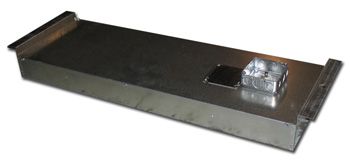
When we are competing against a dryer that utilizes Glass Tubes as the heat source (these tubes are actually an infrared coil inside a heat-resistant quartz glass tube) vs. our Color-Blind Ceramic Panel technology, I have the following comments:
Let me explain why almost all industrial dryer manufacturers choose I.R. Panel Technology over I.R. Glass Tubes (sometimes referred to as quartz bulbs, although they technically are not, although the sheathing is).
-
Ceramic panels evenly distribute the heat over a surface, typically 12” to 48” (or whatever the panel size is). This provides the benefit of a larger and continuous heating surface. Instead, tubes radiate thin lines/strips of heat because of the bulb design itself.
-
Lawson uses a 3” thick ceramic coating, with the infrared wire embedded near the bottom surface of the ceramic material. This means that you essentially have nearly three inches of high temperature insulation that is “pushing” the heat downward towards the dryer belt.
In contrast, Tubes radiate all the way around their entire surface – this means the heat goes upward as much as downward, and this is terribly inefficient from an energy perspective. Furthermore, Glass Tubes dissipate their heat immediately (i.e. there is essentially zero storage of energy) when the unit is cycled on and off for temperature control purposes. As a result, your dryer has “cold spots” everywhere there is no Tube, and even worse, your ability to maintain an even and consistent temperature is nearly impossible. As a result, wild temperature fluctuations occur inside the heat chamber.
-
Ceramic Panels are, by nature, “color blind” because they do not “glow and reflect” their heat like I.R. Glass Tubes. Instead, I.R. Panels gently emit infrared through the ceramic material downward towards the garment, independent of ink color or garment color.
-
Temperature consistency and regulation is far superior utilizing I.R. Panels vs. Tubes because of four primary reasons:
A. Temperature sensing is more accurate because the thermocouple is in contact with the ceramic panel itself;
B. The ceramic material provides even heat distribution across the entire surface of the element (12” x 48”) vs. strips of ¾” Tubes;
C. There are minimal cold spots in the heat chamber, because of greater I.R. surface area - i.e. the surface area of the infrared panels are substantially greater than the small diameter glass I.R. tubes;
D. I.R. heat lose from cycling a panel on and off is minimal vs. a bulb/tube because bulbs instantly loose all of their heat when cycled off (there is basically zero retention) – this means the thermocouple cannot regulate the inside of your heat chamber accurately. The only way to improve tubes to be somewhat comparable to I.R. panel technology is to us SCR controls and regulate the voltage to the bulb itself (which no one does because of the extra cost involved). -
Please note that no one other than Workhorse uses Tubes in their conveyor dryers. M & R, Lawson, Vastex, Brown, the old American, Precision, Sias, Svecia, Atlas, Elexon, etc… And for all of the above reasons and more!
Furthermore, quartz tube must be heated to around 2500 degrees Fahrenheit to work , as opposed to a ceramic heat panel that heats to around 700 degrees Fahrenheit. Also, it is likely the use of quartz bulbs may increase your utility bill, but will not increase your production.
Here are some other facts:
Since quartz bulbs have a filament in them, they are sensitive to vibration. It is not uncommon for the filaments to break if the dryer is bumped or if the bulbs are mishandled. These bulbs require a reflector to direct the heat. You will be cleaning these reflectors frequently when lint bulbs up and is carbonized by the high operating temperatures of the bulb. The quartz bulb manufacturer state an average 1000 hours use before replacement. This means you will be replacing these bulbs, minimally twice a year with one standard shift. If you run 2 or more shifts, expect to be servicing these bulbs more often. If a bulb goes out in the dryer , it will create a dead spot and not properly cure your ink.How will you know when a bulb is not working?
- I.R. heats objects - quartz tubs do not, they simply radiate heat
- 3” of ceramic material insulation, allows IR to radiate throughout the surface of the ceramic panel.
- Bulbs are simply “hot strips/rods, and do not offer even distribution.
- With quartz tubs/bulbs there are many cold spots in the heat chamber
- I.R. wavelength is in the proper spectrum for rapid ink/object curing
- Directed Energy is generated from our I.R. panel technology
- Panels are “Color Blind”…bulbs are not because of the “reflection-bounce”
- Reflectors get dirty (customers don’t clean and this leads to even greater energy loss
Taking these facts into consideration, including our standard warranty on ceramic heating panels is 3 years with the option to extend them for 10 years, why would anyone consider a quartz conveyor dryer?

